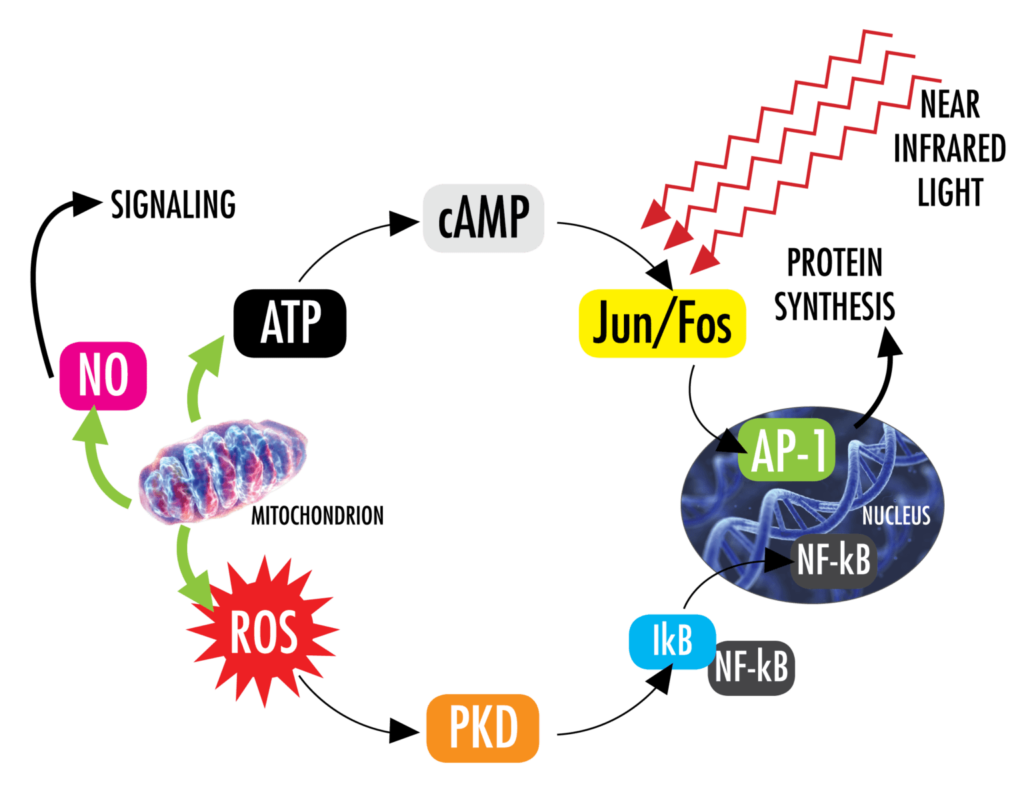Technology
Photobiomodulation
Increased ATP Production
Non-invasive biological response from light
Photobiomodulation therapy (PBMT) is a non-invasive medical treatment with reported outcomes including but not limited to the alleviation of pain or inflammation, immunomodulation, and promotion of wound healing and tissue regeneration.1
The fundamental principle underpinning PBMT is coupling light and biologic response. Specifically, the application of a therapeutic dose of light to injured tissue leads to reduced pain, reduced inflammation, and accelerated healing.2 These clinical observations are understood to be a cellular response mediated by the mitochondria which results in increased ATP production.
Inside the mitochondria
Biological Cascade:

The primary target for the photobiomodulation process is the Cytochrome C complex, which is found in the inner membrane of the cell mitochondria. Cytochrome C is a vital component of the electron transport chain that drives cellular metabolism.
As light is absorbed by Cytochrome C oxidase (COX), it stimulates the electron transport chain to increase the production of adenosine triphosphate (ATP) within the mitochondria. When tissue is damaged, the production of ATP in the cell is impaired which slows down the metabolism of the cell as a protective mechanism. PBM helps restore the oxidative process which helps restore normal cellular function.
In addition to ATP, laser stimulation also produces free nitric oxide (NO) and modulates reactive oxygen species (ROS). NO is a powerful vasodilator and an important cellular signaling molecule involved in many physiological processes. ROS have been shown to affect many important physiological signaling pathways including the inflammatory response. Together, increased NO and improved ROS levels provide an environment for faster signaling, resulting in decreased inflammation.
PBM helps restore normal cellular function which helps prevent apoptosis (cell death). This helps reduce inflammation, edema, and hastens the tissue repair process.
Photobiomodulation
For The Cancer Patient
Oral Mucositis
Prevention
Photobiomodulation Therapy has been recommended in consensus guidelines as prophylactic treatment for Oral Mucositis in cancer patients receiving Hematopoietic Stem Cell Transplant, Head Neck Radiation Therapy, and Chemotherapy.3 Moreover, payers such as Independence Blue Cross consider PBMT medically necessary for preventing Oral Mucositis.4
Palliative
Radiation Dermatitis
Symptom Relief and Control
Radiation Fibrosis
Potential use for prevention and reversal of symptoms
Chemo Induced Alopecia
Preventing Hair Loss
Chemo Induced Neuropathy
Improved Neurological Function
Lymphedema
Promising, but more research needed
1. Anders JJ, Lanzafame RJ, Arany PR. Low-level light/laser therapy versus photobiomodulation therapy. Photomedicine and Laser Surgery. 2015; 33(4): 183-184.
2. Karu TI. Low power laser therapy. In: Vo-Dinh T, editor.Biomedical Photonics Handbook. Boca Raton(FL) CRC Press; 2003: 48-1-48-25.
3. Elad S, Cheng KKF, Lalla RV, et al. MASCC/ISOO clinical practice guidelines for the management of mucositis secondary to cancer therapy. Cancer 2020; 126:4423.
4. Independence Blue Cross Policy 07.00.14g
5. Carvalho P.A.G. et al. Evaluation of low-level laser therapy in the prevention and treatment of radiation-induced mucositis: A double-blind randomized study in head and neck cancer
patients. Oral Oncol. 2011 Dec;47(12):1176-81.
6. Hodgson B, et al. Amelioration of oral mucositis pain by NASA near-infrared light-emitting diodes in bone marrow transplant patients. Support Care Cancer. 2012 Jul;20(7):1405-15.
7. Hottz, F., Herchenhorn, D., Lenzi, J. et al. Photobiomodulation as a treatment for dermatitis caused by chemoradiotherapy for squamous cell anal carcinoma: case report and literature review. Radiat Oncol 17, 49 (2022). https://doi.org/10.1186/s13014-022-02015-4
8. Moses Tam, Praveen R. Arany, Jolien Robijns, Rebeca Vasconcelos, Patricia Corby, and Kenneth Hu.Photobiomodulation Therapy to Mitigate Radiation Fibrosis Syndrome.Photobiomodulation, Photomedicine, and Laser Surgery.Jun 2020.355-363. http://doi.org/10.1089/photob.2019.4766
9.Hamblin MR. Photobiomodulation for the management of alopecia: mechanisms of action, patient selection and perspectives. Clin Cosmet Investig Dermatol. 2019 Sep 6;12:669-678. doi: 10.2147/CCID.S184979. PMID: 31686888; PMCID: PMC6737896.
10. Argenta, P.A., Ballman, K.V., Geller, M.A., Carson, L.F., Ghebre, R., Mullany, S.A., . . . Erickson, B.K. (2017). The effect of photobiomodulation on chemotherapy-induced peripheral neuropathy: A randomized, sham-controlled clinical trial. Gynecologic Oncology, 144, 159–166.
11.Baxter, G.D., Liu, L., Petrich, S. et al. Low level laser therapy (Photobiomodulation therapy) for breast cancer-related lymphedema: a systematic review. BMC Cancer 17, 833 (2017). https://doi.org/10.1186/s12885-017-3852-x

